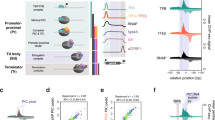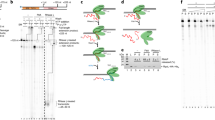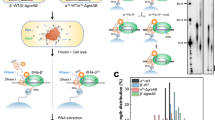Abstract
The archaeal transcription apparatus is closely related to the eukaryotic RNA polymerase (RNAP) II system, while archaeal genomes are more similar to bacteria with densely packed genes organized in operons. This makes understanding transcription in archaea vital, both in terms of molecular mechanisms and evolution. Very little is known about how archaeal cells orchestrate transcription on a systems level. We have characterized the genome-wide occupancy of the Methanocaldococcus jannaschii transcription machinery and its transcriptome. Our data reveal how the TATA and BRE promoter elements facilitate recruitment of the essential initiation factors TATA-binding protein and transcription factor B, respectively, which in turn are responsible for the loading of RNAP into the transcription units. The occupancies of RNAP and Spt4/5 strongly correlate with each other and with RNA levels. Our results show that Spt4/5 is a general elongation factor in archaea as its presence on all genes matches RNAP. Spt4/5 is recruited proximal to the transcription start site on the majority of transcription units, while on a subset of genes, including rRNA and CRISPR loci, Spt4/5 is recruited to the transcription elongation complex during early elongation within 500 base pairs of the transcription start site and akin to its bacterial homologue NusG.
This is a preview of subscription content, access via your institution
Access options
Access Nature and 54 other Nature Portfolio journals
Get Nature+, our best-value online-access subscription
$29.99 / 30 days
cancel any time
Subscribe to this journal
Receive 12 digital issues and online access to articles
$119.00 per year
only $9.92 per issue
Buy this article
- Purchase on Springer Link
- Instant access to full article PDF
Prices may be subject to local taxes which are calculated during checkout






Similar content being viewed by others
References
Werner, F. Structural evolution of multisubunit RNA polymerases. Trends Microbiol. 16, 247–250 (2008).
Werner, F. & Grohmann, D. Evolution of multisubunit RNA polymerases in the three domains of life. Nat. Rev. Microbiol. 9, 85–98 (2011).
Korkhin, Y. et al. Evolution of complex RNA polymerases: the complete archaeal RNA polymerase structure. PLoS Biol. 7, e1000102 (2009).
Hirtreiter, A., Grohmann, D. & Werner, F. Molecular mechanisms of RNA polymerase—the F/E (RPB4/7) complex is required for high processivity in vitro. Nucleic Acids Res. 38, 585–596 (2010).
Li, E., Reich, C. I. & Olsen, G. J. A whole-genome approach to identifying protein binding sites: promoters in Methanocaldococcus (Methanococcus) jannaschii. Nucleic Acids Res. 36, 6948–6958 (2008).
Zhang, J., Li, E. & Olsen, G. J. Protein-coding gene promoters in Methanocaldococcus (Methanococcus) jannaschii. Nucleic Acids Res. 37, 3588–3601 (2009).
Werner, F. & Weinzierl, R. O. A recombinant RNA polymerase II-like enzyme capable of promoter-specific transcription. Mol. Cell 10, 635–646 (2002).
Gietl, A. et al. Eukaryotic and archaeal TBP and TFB/TF(II)B follow different promoter DNA bending pathways. Nucleic Acids Res. 42, 6219–6231 (2014).
Blombach, F. et al. Archaeal TFEα/β is a hybrid of TFIIE and the RNA polymerase III subcomplex hRPC62/39. eLife 4, e08378 (2015).
Grohmann, D. et al. The initiation factor TFE and the elongation factor Spt4/5 compete for the RNAP clamp during transcription initiation and elongation. Mol. Cell 43, 263–274 (2011).
Werner, F. A nexus for gene expression-molecular mechanisms of Spt5 and NusG in the three domains of life. J. Mol. Biol. 417, 13–27 (2012).
Sevostyanova, A., Svetlov, V., Vassylyev, D. G. & Artsimovitch, I. The elongation factor RfaH and the initiation factor sigma bind to the same site on the transcription elongation complex. Proc. Natl Acad. Sci. USA 105, 865–870 (2008).
Mayer, A. et al. Uniform transitions of the general RNA polymerase II transcription complex. Nat. Struct. Mol. Biol. 17, 1272–1278 (2010).
Mooney, R. A. et al. Regulator trafficking on bacterial transcription units in vivo. Mol. Cell 33, 97–108 (2009).
Kadonaga, J. T. Perspectives on the RNA polymerase II core promoter. Wiley Interdiscip. Rev. Dev. Biol. 1, 40–51 (2012).
Nagy, J. et al. Complete architecture of the archaeal RNA polymerase open complex from single-molecule FRET and NPS. Nat. Commun. 6, 6161 (2015).
Schulz, S. et al. TFE and Spt4/5 open and close the RNA polymerase clamp during the transcription cycle. Proc. Natl Acad. Sci. USA 113, E1816–E1825 (2016).
Bell, S. D., Jaxel, C., Nadal, M., Kosa, P. F. & Jackson, S. P. Temperature, template topology, and factor requirements of archaeal transcription. Proc. Natl Acad. Sci. USA 95, 15218–15222 (1998).
Jäger, D., Förstner, K. U., Sharma, C. M., Santangelo, T. J. & Reeve, J. N. Primary transcriptome map of the hyperthermophilic archaeon Thermococcus kodakarensis. BMC Genomics 15, 684 (2014).
Jäger, D. et al. Deep sequencing analysis of the Methanosarcina mazei Go1 transcriptome in response to nitrogen availability. Proc. Natl Acad. Sci. USA 106, 21878–21882 (2009).
Li, J. et al. Global mapping transcriptional start sites revealed both transcriptional and post-transcriptional regulation of cold adaptation in the methanogenic archaeon Methanolobus psychrophilus. Sci. Rep. 5, 9209 (2015).
Wurtzel, O. et al. A single-base resolution map of an archaeal transcriptome. Genome Res. 20, 133–141 (2010).
Babski, J. et al. Genome-wide identification of transcriptional start sites in the haloarchaeon Haloferax volcanii based on differential RNA-Seq (dRNA-Seq). BMC Genomics 17, 629 (2016).
Seitzer, P., Wilbanks, E. G., Larsen, D. J. & Facciotti, M. T. A Monte Carlo-based framework enhances the discovery and interpretation of regulatory sequence motifs. BMC Bioinformatics 13, 317 (2012).
Blombach, F., Smollett, K. L., Grohmann, D. & Werner, F. Molecular mechanisms of transcription initiation—structure, function, and evolution of TFE/TFIIE-like factors and open complex formation. J. Mol. Biol. 428, 2592–2606 (2016).
Werner, F. & Weinzierl, R. O. Direct modulation of RNA polymerase core functions by basal transcription factors. Mol. Cell. Biol. 25, 8344–8355 (2005).
Qureshi, S. A., Bell, S. D. & Jackson, S. P. Factor requirements for transcription in the archaeon Sulfolobus shibatae. EMBO J. 16, 2927–2936 (1997).
Burmann, B. M. et al. A NusE:NusG complex links transcription and translation. Science 328, 501–504 (2010).
Proshkin, S., Rahmouni, A. R., Mironov, A. & Nudler, E. Cooperation between translating ribosomes and RNA polymerase in transcription elongation. Science 328, 504–508 (2010).
French, S. L., Santangelo, T. J., Beyer, A. L. & Reeve, J. N. Transcription and translation are coupled in Archaea. Mol. Biol. Evol. 24, 893–895 (2007).
Brenneis, M., Hering, O., Lange, C. & Soppa, J. Experimental characterization of Cis-acting elements important for translation and transcription in halophilic Archaea. PLoS Genet. 3, e229 (2007).
Torarinsson, E., Klenk, H. P. & Garrett, R. A. Divergent transcriptional and translational signals in Archaea. Environ. Microbiol. 7, 47–54 (2005).
Koide, T. et al. Prevalence of transcription promoters within archaeal operons and coding sequences. Mol. Syst. Biol. 5, 285 (2009).
Toffano-Nioche, C. et al. RNA at 92 °C: the non-coding transcriptome of the hyperthermophilic archaeon Pyrococcus abyssi. RNA Biol. 10, 1211–1220 (2013).
Yang, C., Bolotin, E., Jiang, T., Sladek, F. M. & Martinez, E. Prevalence of the initiator over the TATA box in human and yeast genes and identification of DNA motifs enriched in human TATA-less core promoters. Gene 389, 52–65 (2007).
Qureshi, S. A. Role of the Sulfolobus shibatae viral T6 initiator in conferring promoter strength and in influencing transcription start site selection. Can. J. Microbiol. 52, 1136–1140 (2006).
Bell, S. D. & Jackson, S. P. The role of transcription factor B in transcription initiation and promoter clearance in the archaeon Sulfolobus acidocaldarius. J. Biol. Chem. 275, 12934–12940 (2000).
Shultzaberger, R. K., Chen, Z., Lewis, K. A. & Schneider, T. D. Anatomy of Escherichia coli σ70 promoters. Nucleic Acids Res. 35, 771–788 (2007).
Basu, R. S. et al. Structural basis of transcription initiation by bacterial RNA polymerase holoenzyme. J. Biol. Chem. 289, 24549–24559 (2014).
Ehrensberger, A. H., Kelly, G. P. & Svejstrup, J. Q. Mechanistic interpretation of promoter-proximal peaks and RNAPII density maps. Cell 154, 713–715 (2013).
Hirtreiter, A. et al. Spt4/5 stimulates transcription elongation through the RNA polymerase clamp coiled-coil motif. Nucleic Acids Res. 38, 4040–4051 (2010).
Diamant, G., Bahat, A. & Dikstein, R. The elongation factor Spt5 facilitates transcription initiation for rapid induction of inflammatory-response genes. Nat. Commun. 7, 11547 (2016).
Larochelle, S. et al. Cyclin-dependent kinase control of the initiation-to-elongation switch of RNA polymerase II. Nat. Struct. Mol. Biol. 19, 1108–1115 (2012).
Arnvig, K. B. et al. Evolutionary comparison of ribosomal operon antitermination function. J. Bacteriol. 190, 7251–7257 (2008).
Micorescu, M. et al. archaeal transcription: function of an alternative transcription factor B from Pyrococcus furiosus. J. Bacteriol. 190, 157–167 (2008).
Jensen, K. F. & Pedersen, S. Metabolic growth rate control in Escherichia coli may be a consequence of subsaturation of the macromolecular biosynthetic apparatus with substrates and catalytic components. Microbiol. Rev. 54, 89–100 (1990).
Peeters, E., Driessen, R. P., Werner, F. & Dame, R. T. The interplay between nucleoid organization and transcription in archaeal genomes. Nat. Rev. Microbiol. 13, 333–341 (2015).
Ouhammouch, M., Dewhurst, R. E., Hausner, W., Thomm, M. & Geiduschek, E. P. Activation of archaeal transcription by recruitment of the TATA-binding protein. Proc. Natl Acad. Sci. USA 100, 5097–5102 (2003).
Churchman, L. S. & Weissman, J. S. Native elongating transcript sequencing (NET-seq). Curr. Protoc. Mol. Biol. 4, 1–17 (2012).
Nojima, T. et al. Mammalian NET-Seq reveals genome-wide nascent transcription coupled to RNA processing. Cell 161, 526–540 (2015).
Jones, W. J., Leigh, J. A., Mayer, F., Woese, C. R. & Wolfe, R. S. Methanococcus jannaschii sp. nov., an extremely thermophilic methanogen from a submarine hydrothermal vent. Arch. Microbiol. 136, 254–261 (1983).
Smollett, K., Blombach, F. & Werner, F. Transcription in Archaea: preparation of Methanocaldococcus jannaschii transcription machinery. Methods Mol. Biol. 1276, 291–303 (2015).
Reichelt, R., Gindner, A., Thomm, M. & Hausner, W. Genome-wide binding analysis of the transcriptional regulator TrmBL1 in Pyrococcus furiosus. BMC Genomics 17, 40 (2016).
Liu, W., Vierke, G., Wenke, A. K., Thomm, M. & Ladenstein, R. Crystal structure of the archaeal heat shock regulator from Pyrococcus furiosus: a molecular chimera representing eukaryal and bacterial features. J. Mol. Biol. 369, 474–488 (2007).
Andrews, S. FastQC: A Quality Control Tool for High Throughput Sequence Data (2010); http://www.bioinformatics.babraham.ac.uk/projects/fastqc
Langmead, B., Trapnell, C., Pop, M. & Salzberg, S. L. Ultrafast and memory-efficient alignment of short DNA sequences to the human genome. Genome Biol. 10, R25 (2009).
Quinlan, A. R. & Hall, I. M. BEDTools: a flexible suite of utilities for comparing genomic features. Bioinformatics 26, 841–842 (2010).
R Core Team. R: A Language and Environment for Statistical Computing (R Foundation for Statistical Computing, 2014); http://www.R-project.org
Crooks, G. E., Hon, G., Chandonia, J. M. & Brenner, S. E. Weblogo: a sequence logo generator. Genome Res. 14, 1188–1190 (2004).
Bailey, T. L. et al. MEME SUITE: tools for motif discovery and searching. Nucleic Acids Res. 37, W202–W208 (2009).
Smollett, K., Blombach, F. & Werner, F. Transcription in Archaea: in vitro transcription assays for mjRNAP. Methods Mol. Biol. 1276, 305–314 (2015).
Arnvig, K. B. & Young, D. B. Identification of small RNAs in Mycobacterium tuberculosis. Mol. Microbiol. 73, 397–408 (2009).
Wickham, H. ggplot2: Elegant Graphics for Data Analysis (Springer, 2009).
Acknowledgements
The authors thank J. Bähler and D. Bitton for advice throughout this project. The authors also thank T. Arnvig, D. Grohman and other members of the RNAP laboratory for encouragement and critical reading of the manuscript. Research in the RNAP laboratory at University College London is funded by Wellcome Trust Investigator Award WT096553MA (to F.W.).
Author information
Authors and Affiliations
Contributions
K.S. designed and performed experiments, analysed data and wrote the manuscript. F.B. performed experiments and wrote the manuscript. R.R. and M.T. helped with fermenter growth and crosslinking, and provided biomass. F.W. conceptualized the study, designed experiments and wrote the manuscript.
Corresponding author
Ethics declarations
Competing interests
The authors declare no competing financial interests.
Supplementary information
Supplementary Information
Supplementary Notes; Supplementary Table 1 and 4–6; Supplementary Figures 1–7; Supplementary References. (PDF 8146 kb)
Supplementary Table 2
Identified TSS and their promoter elements. (XLSX 144 kb)
Supplementary Table 3
Gene organisation of Mja. (XLSX 566 kb)
Rights and permissions
About this article
Cite this article
Smollett, K., Blombach, F., Reichelt, R. et al. A global analysis of transcription reveals two modes of Spt4/5 recruitment to archaeal RNA polymerase. Nat Microbiol 2, 17021 (2017). https://doi.org/10.1038/nmicrobiol.2017.21
Received:
Accepted:
Published:
DOI: https://doi.org/10.1038/nmicrobiol.2017.21
This article is cited by
-
DNA-bridging by an archaeal histone variant via a unique tetramerisation interface
Communications Biology (2023)
-
Promoter-proximal elongation regulates transcription in archaea
Nature Communications (2021)
-
DNA origami-based single-molecule force spectroscopy elucidates RNA Polymerase III pre-initiation complex stability
Nature Communications (2020)
-
FttA is a CPSF73 homologue that terminates transcription in Archaea
Nature Microbiology (2020)
-
Structure and mechanisms of viral transcription factors in archaea
Extremophiles (2017)



